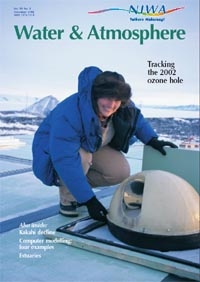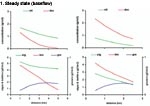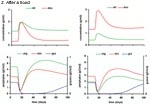PDF of this article (830 KB)

Kit Rutherford
A new catchment model is being designed for use by non-specialists.
It is widely accepted that agriculture is not good for streams. Compared with streams in unfarmed catchments, those draining farmland have higher temperatures, higher nutrient and sediment concentrations, more problems with excessive plant growth, and a lower diversity of aquatic invertebrates and fish.
National and regional policy now promotes “sustainable” agriculture, which includes measures to protect or restore rural streams by optimising stocking and fertiliser application rates, excluding stock from streams, careful treatment and land disposal of dairy-shed wastes, providing riparian buffer strips along streams, and planting shade trees along stream banks.
But how can landowners and regional councils decide on the most cost-effective combination of control measures in a particular catchment?
This is especially difficult for nutrient runoff from farmland. High nutrient – especially nitrogen – concentrations cause excessive weed and algal growth, which can lead to drainage problems, clogging of pumps, and fluctuations in pH and dissolved oxygen that harm stream life.
The effects of actions by landowners often occur downstream of their properties and accumulate down a catchment. So it may be difficult for landowners to appreciate the benefits of their own control measures, and for catchment planners to disentangle the activities of many different landowners. This is where computer models can help.
Over several years NIWA has undertaken experimental and modelling studies relating to the effects of agriculture on catchments. However, none of the models currently in use simulates catchment runoff, nutrient removal in riparian zones and in-stream effects. In addition, all must be run by an experienced modeller.
What is needed is a relatively simple decision-support system for use by non-modellers. Developing such a tool presents quite a challenge, but the result could be a real help in considering options and formulating policy. More detailed investigations (including more sophisticated modelling) would still be available when necessary.
A new decision-support system
We are developing a new user-friendly decision-support system that overcomes the deficiencies of existing models. A prototype version – Riparian Use of Land and its Effects on Streams (RULES) – is currently being evaluated.
The RULES prototype is programmed in EXCEL-VBA. It takes a few minutes to run a one-year simulation (with daily calculations) for a 100 ha catchment containing 10 stream reaches. The model provides output on a range of catchment characteristics:
- Specifying daily rainfall provides, in each sub-catchment, predictions of surface flow, soil moisture, and groundwater inflows.
- Nitrogen flux is estimated using published concentrations in pore water leaving the root zone that vary with land use.
- Water and nitrogen are transported to the stream using surface flow and groundwater models.
- Surface flow and some groundwater enter the riparian zone where a denitrification model predicts nitrate removal.
- Carbon production in the riparian zone is estimated from published measurements and added to the stream.
- Changes over time in stream nitrogen, carbon, algae, biofilms, grazers and detritus are then simulated using simplified versions of our other models.
To assess the likely impact of various management scenarios, the user can vary: the land use, which changes the root zone nitrogen concentration; the amount of nitrogen removal in groundwater and the riparian zone; and stream shade, which affects plant growth and nitrate uptake.
Using RULES
A hypothetical example shows how RULES works in predicting the effects of restoring riparian vegetation along a small, spring-fed headwater stream.
The stream bed contains cobbles with growths of algae and biofilms (thin organic layers comprising mainly bacteria), but no water plants. Algae get energy from the sun while biofilms use dissolved organic carbon (DOC). Both consume nitrate. Invertebrate grazers (such as snails or mayflies) eat biofilms and algae equally, and grow better in cool, shaded streams. Algae and biofilms dislodged during grazing become detritus, which breaks down to release nitrate and carbon for re-use by downstream algae and biofilms. Before restoration, the stream has negligible shade.
The graphs show predictions from the model in two situations.
1. After a long period of baseflow

With no restoration the spring is the only source of nitrate and DOC, whose concen-trations decrease downstream as they are taken up by algae and biofilms. Grazer biomass peaks at 4 km, then starts to decline.
Riparian restoration increases DOC inflow and shade, and reduces water temperature and nitrate inflow. Lower nitrate and light reduce algal growth. Higher DOC increases biofilm growth. Lower temperature and more biofilm favour grazers, but this is balanced by lower algal productivity, so grazer biomass remains unchanged.
2. After a flood

High flows on days 10–15 scour algae, biofilms, grazers and detritus from the bed, and inject a pulse of high-nutrient water into the stream. Just after the flood, algae and biofilms re-grow rapidly because few grazers survive the flood. A “post-spate” bloom is predicted, as is occasionally observed in the field. As grazers return, they reduce algae and biofilms to the steady-state values.
In both situations, the main effect of restoration is to promote biofilms rather than algae. If biofilms and algae have different nutritional value, shade restoration could have important implications for aquatic insects and fish. Further research is required on the food preferences of New Zealand aquatic insects and we assume here that biofilms and algae have the same nutritional value.
Shade: good and bad
These simulations confirm that restoring shade to a stream can be a two-edged sword. Benefits include reducing light and temperature, stabilising banks, and providing cover habitat for fish and adult stream insects. Riparian vegetation also removes some nitrogen from catchment runoff before it reaches the stream.
However, by reducing the growth of algae, shade reduces the capacity of the stream to absorb nitrate. So increased shade could result in more soluble nitrogen leaving the catchment and pose a threat of eutrophication in downstream lakes and estuaries.
More trials planned
Interactions between shade, flow, nitrate, periphyton and grazers are complex, and the effect of altering one variable is not always obvious. Even at this early stage, RULES is proving useful for testing our knowledge of catchments, riparian buffer zones and streams in a way that was not possible previously. We hope that eventually it will serve a similar purpose for planners, landowners and managers.
Further work is underway to test RULES and improve its ability to quantify the effects of landuse and riparian management on stream ecosystems. In the longer term we plan to develop a web-based version of RULES that uses GIS information. It might also be useful to develop similar models for phosphorus, sediment and faecal microbes. Testing so far gives a measure of confidence that RULES will have an important role to play in the arsenal of available catchment models.
Kit Rutherford is based at NIWA in Hamilton.
